Professional Nurse: Code of Conduct, Ethics, and Competency Analysis
VerifiedAdded on 2020/03/16
|8
|2237
|298
Report
AI Summary
This report analyzes a case study involving a registered nurse whose actions deviated from professional standards of conduct, ethics, and competency. The analysis examines the nurse's failure to document patient assessments, report critical conditions, and adhere to the established code of conduct. The report highlights violations of competency standards, such as critical thinking and outcome evaluation, and professional code statements regarding practice standards and reflective, ethical conduct. The case study provides valuable lessons for aspiring nurses, emphasizing the importance of documentation, appropriate response to patient conditions, and continuous learning within the profession. The report concludes that adherence to professional codes and standards is crucial in nursing practice, and that even minor errors can have significant consequences for patient well-being. The nurse's acceptance of responsibility and the board's recommendation for mentorship are also discussed.
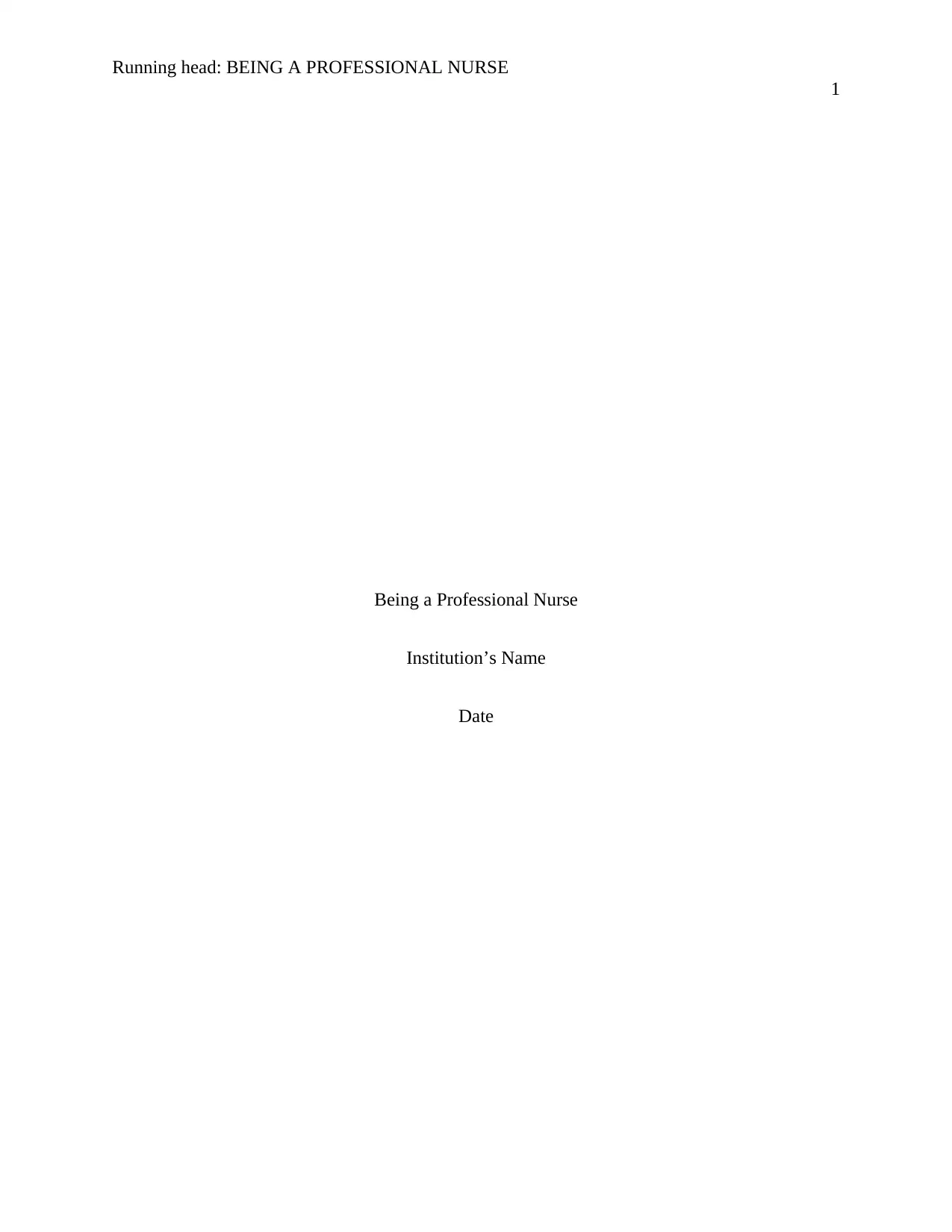
Running head: BEING A PROFESSIONAL NURSE
1
Being a Professional Nurse
Institution’s Name
Date
1
Being a Professional Nurse
Institution’s Name
Date
Paraphrase This Document
Need a fresh take? Get an instant paraphrase of this document with our AI Paraphraser
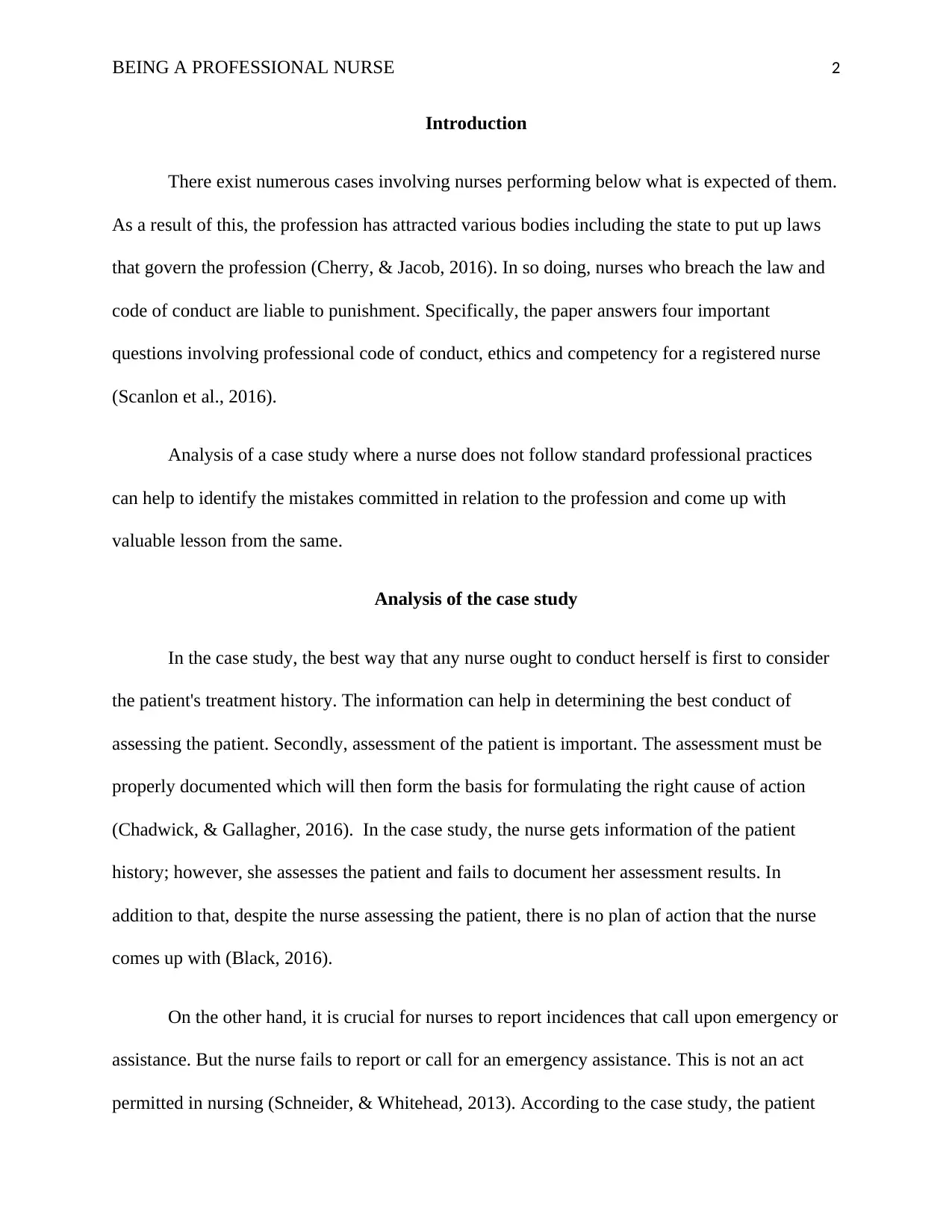
BEING A PROFESSIONAL NURSE 2
Introduction
There exist numerous cases involving nurses performing below what is expected of them.
As a result of this, the profession has attracted various bodies including the state to put up laws
that govern the profession (Cherry, & Jacob, 2016). In so doing, nurses who breach the law and
code of conduct are liable to punishment. Specifically, the paper answers four important
questions involving professional code of conduct, ethics and competency for a registered nurse
(Scanlon et al., 2016).
Analysis of a case study where a nurse does not follow standard professional practices
can help to identify the mistakes committed in relation to the profession and come up with
valuable lesson from the same.
Analysis of the case study
In the case study, the best way that any nurse ought to conduct herself is first to consider
the patient's treatment history. The information can help in determining the best conduct of
assessing the patient. Secondly, assessment of the patient is important. The assessment must be
properly documented which will then form the basis for formulating the right cause of action
(Chadwick, & Gallagher, 2016). In the case study, the nurse gets information of the patient
history; however, she assesses the patient and fails to document her assessment results. In
addition to that, despite the nurse assessing the patient, there is no plan of action that the nurse
comes up with (Black, 2016).
On the other hand, it is crucial for nurses to report incidences that call upon emergency or
assistance. But the nurse fails to report or call for an emergency assistance. This is not an act
permitted in nursing (Schneider, & Whitehead, 2013). According to the case study, the patient
Introduction
There exist numerous cases involving nurses performing below what is expected of them.
As a result of this, the profession has attracted various bodies including the state to put up laws
that govern the profession (Cherry, & Jacob, 2016). In so doing, nurses who breach the law and
code of conduct are liable to punishment. Specifically, the paper answers four important
questions involving professional code of conduct, ethics and competency for a registered nurse
(Scanlon et al., 2016).
Analysis of a case study where a nurse does not follow standard professional practices
can help to identify the mistakes committed in relation to the profession and come up with
valuable lesson from the same.
Analysis of the case study
In the case study, the best way that any nurse ought to conduct herself is first to consider
the patient's treatment history. The information can help in determining the best conduct of
assessing the patient. Secondly, assessment of the patient is important. The assessment must be
properly documented which will then form the basis for formulating the right cause of action
(Chadwick, & Gallagher, 2016). In the case study, the nurse gets information of the patient
history; however, she assesses the patient and fails to document her assessment results. In
addition to that, despite the nurse assessing the patient, there is no plan of action that the nurse
comes up with (Black, 2016).
On the other hand, it is crucial for nurses to report incidences that call upon emergency or
assistance. But the nurse fails to report or call for an emergency assistance. This is not an act
permitted in nursing (Schneider, & Whitehead, 2013). According to the case study, the patient
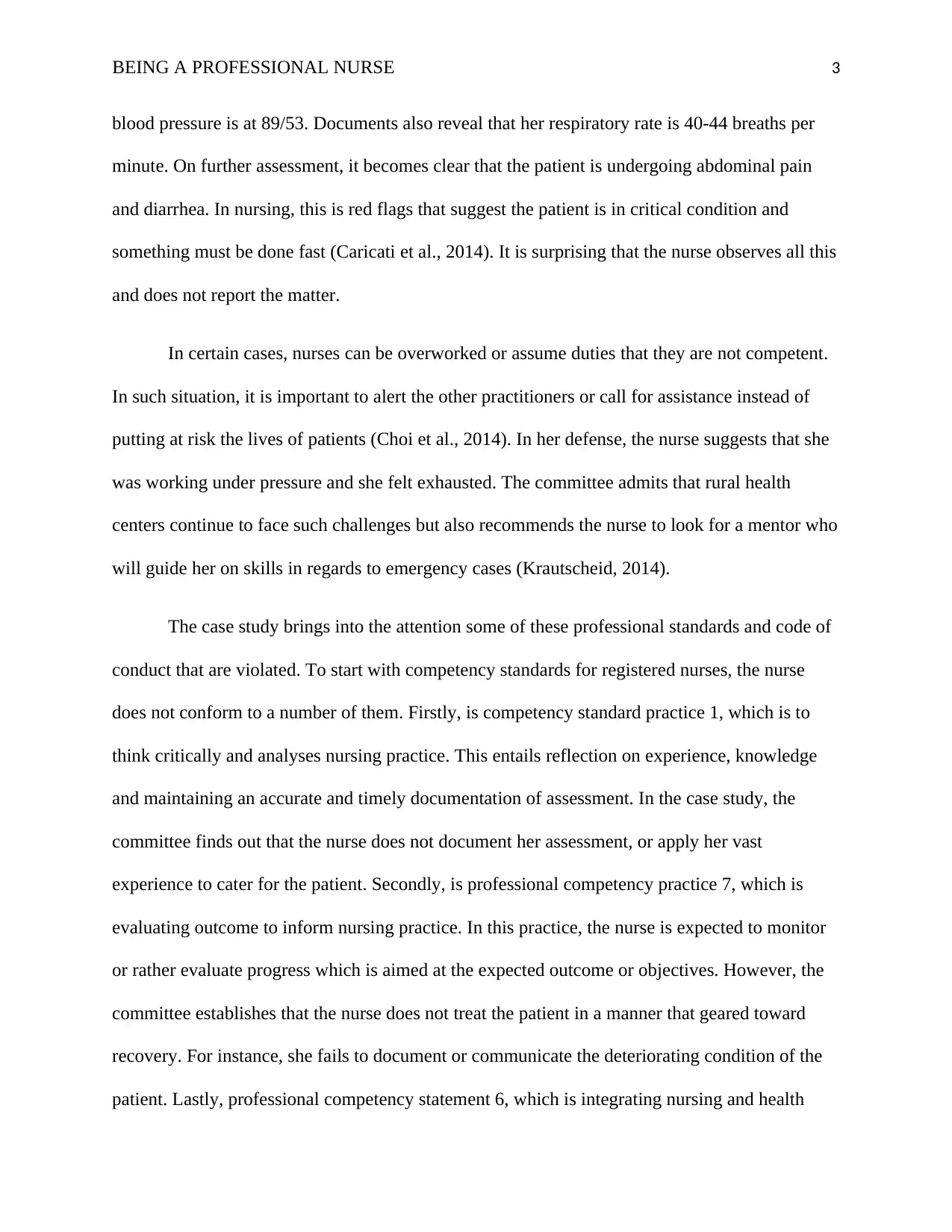
BEING A PROFESSIONAL NURSE 3
blood pressure is at 89/53. Documents also reveal that her respiratory rate is 40-44 breaths per
minute. On further assessment, it becomes clear that the patient is undergoing abdominal pain
and diarrhea. In nursing, this is red flags that suggest the patient is in critical condition and
something must be done fast (Caricati et al., 2014). It is surprising that the nurse observes all this
and does not report the matter.
In certain cases, nurses can be overworked or assume duties that they are not competent.
In such situation, it is important to alert the other practitioners or call for assistance instead of
putting at risk the lives of patients (Choi et al., 2014). In her defense, the nurse suggests that she
was working under pressure and she felt exhausted. The committee admits that rural health
centers continue to face such challenges but also recommends the nurse to look for a mentor who
will guide her on skills in regards to emergency cases (Krautscheid, 2014).
The case study brings into the attention some of these professional standards and code of
conduct that are violated. To start with competency standards for registered nurses, the nurse
does not conform to a number of them. Firstly, is competency standard practice 1, which is to
think critically and analyses nursing practice. This entails reflection on experience, knowledge
and maintaining an accurate and timely documentation of assessment. In the case study, the
committee finds out that the nurse does not document her assessment, or apply her vast
experience to cater for the patient. Secondly, is professional competency practice 7, which is
evaluating outcome to inform nursing practice. In this practice, the nurse is expected to monitor
or rather evaluate progress which is aimed at the expected outcome or objectives. However, the
committee establishes that the nurse does not treat the patient in a manner that geared toward
recovery. For instance, she fails to document or communicate the deteriorating condition of the
patient. Lastly, professional competency statement 6, which is integrating nursing and health
blood pressure is at 89/53. Documents also reveal that her respiratory rate is 40-44 breaths per
minute. On further assessment, it becomes clear that the patient is undergoing abdominal pain
and diarrhea. In nursing, this is red flags that suggest the patient is in critical condition and
something must be done fast (Caricati et al., 2014). It is surprising that the nurse observes all this
and does not report the matter.
In certain cases, nurses can be overworked or assume duties that they are not competent.
In such situation, it is important to alert the other practitioners or call for assistance instead of
putting at risk the lives of patients (Choi et al., 2014). In her defense, the nurse suggests that she
was working under pressure and she felt exhausted. The committee admits that rural health
centers continue to face such challenges but also recommends the nurse to look for a mentor who
will guide her on skills in regards to emergency cases (Krautscheid, 2014).
The case study brings into the attention some of these professional standards and code of
conduct that are violated. To start with competency standards for registered nurses, the nurse
does not conform to a number of them. Firstly, is competency standard practice 1, which is to
think critically and analyses nursing practice. This entails reflection on experience, knowledge
and maintaining an accurate and timely documentation of assessment. In the case study, the
committee finds out that the nurse does not document her assessment, or apply her vast
experience to cater for the patient. Secondly, is professional competency practice 7, which is
evaluating outcome to inform nursing practice. In this practice, the nurse is expected to monitor
or rather evaluate progress which is aimed at the expected outcome or objectives. However, the
committee establishes that the nurse does not treat the patient in a manner that geared toward
recovery. For instance, she fails to document or communicate the deteriorating condition of the
patient. Lastly, professional competency statement 6, which is integrating nursing and health
⊘ This is a preview!⊘
Do you want full access?
Subscribe today to unlock all pages.

Trusted by 1+ million students worldwide
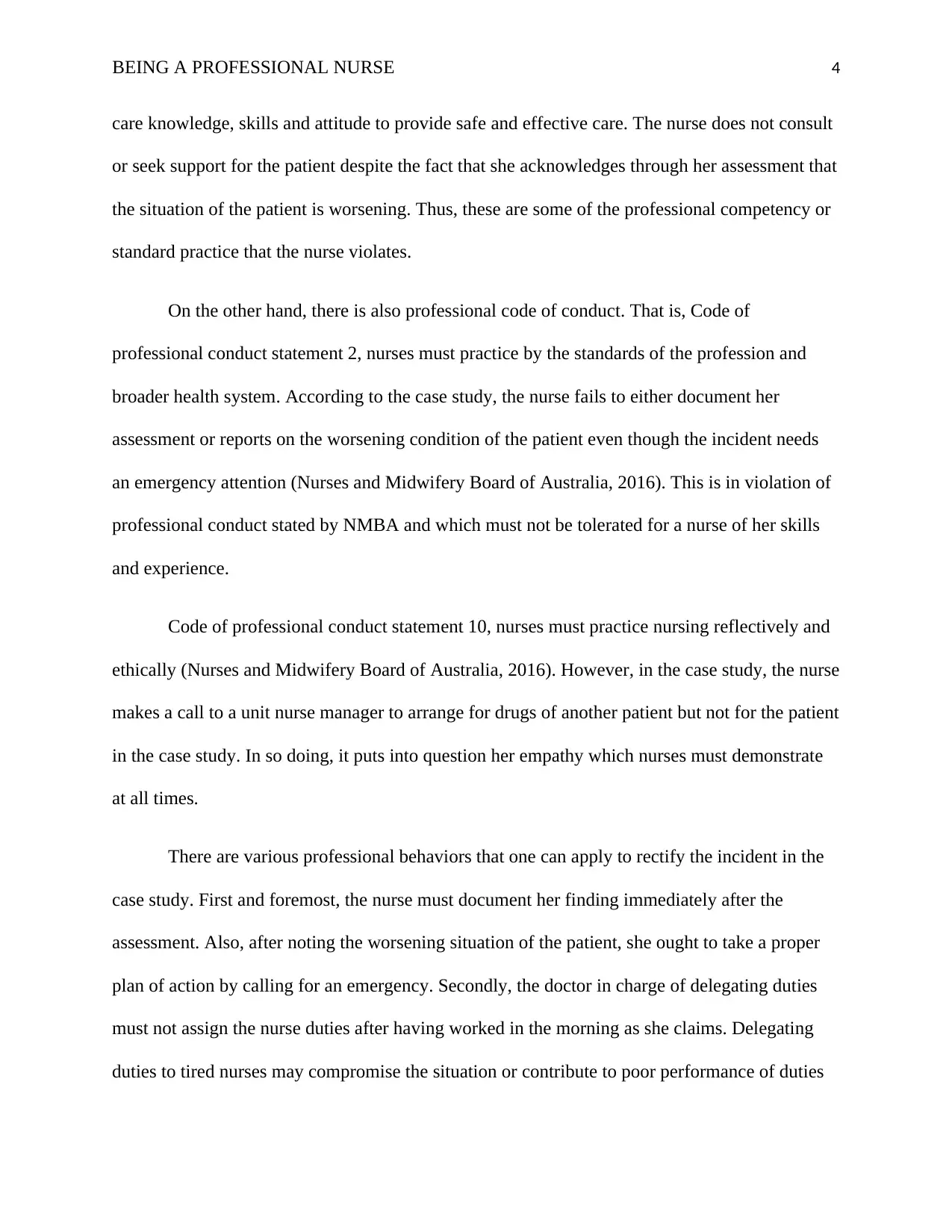
BEING A PROFESSIONAL NURSE 4
care knowledge, skills and attitude to provide safe and effective care. The nurse does not consult
or seek support for the patient despite the fact that she acknowledges through her assessment that
the situation of the patient is worsening. Thus, these are some of the professional competency or
standard practice that the nurse violates.
On the other hand, there is also professional code of conduct. That is, Code of
professional conduct statement 2, nurses must practice by the standards of the profession and
broader health system. According to the case study, the nurse fails to either document her
assessment or reports on the worsening condition of the patient even though the incident needs
an emergency attention (Nurses and Midwifery Board of Australia, 2016). This is in violation of
professional conduct stated by NMBA and which must not be tolerated for a nurse of her skills
and experience.
Code of professional conduct statement 10, nurses must practice nursing reflectively and
ethically (Nurses and Midwifery Board of Australia, 2016). However, in the case study, the nurse
makes a call to a unit nurse manager to arrange for drugs of another patient but not for the patient
in the case study. In so doing, it puts into question her empathy which nurses must demonstrate
at all times.
There are various professional behaviors that one can apply to rectify the incident in the
case study. First and foremost, the nurse must document her finding immediately after the
assessment. Also, after noting the worsening situation of the patient, she ought to take a proper
plan of action by calling for an emergency. Secondly, the doctor in charge of delegating duties
must not assign the nurse duties after having worked in the morning as she claims. Delegating
duties to tired nurses may compromise the situation or contribute to poor performance of duties
care knowledge, skills and attitude to provide safe and effective care. The nurse does not consult
or seek support for the patient despite the fact that she acknowledges through her assessment that
the situation of the patient is worsening. Thus, these are some of the professional competency or
standard practice that the nurse violates.
On the other hand, there is also professional code of conduct. That is, Code of
professional conduct statement 2, nurses must practice by the standards of the profession and
broader health system. According to the case study, the nurse fails to either document her
assessment or reports on the worsening condition of the patient even though the incident needs
an emergency attention (Nurses and Midwifery Board of Australia, 2016). This is in violation of
professional conduct stated by NMBA and which must not be tolerated for a nurse of her skills
and experience.
Code of professional conduct statement 10, nurses must practice nursing reflectively and
ethically (Nurses and Midwifery Board of Australia, 2016). However, in the case study, the nurse
makes a call to a unit nurse manager to arrange for drugs of another patient but not for the patient
in the case study. In so doing, it puts into question her empathy which nurses must demonstrate
at all times.
There are various professional behaviors that one can apply to rectify the incident in the
case study. First and foremost, the nurse must document her finding immediately after the
assessment. Also, after noting the worsening situation of the patient, she ought to take a proper
plan of action by calling for an emergency. Secondly, the doctor in charge of delegating duties
must not assign the nurse duties after having worked in the morning as she claims. Delegating
duties to tired nurses may compromise the situation or contribute to poor performance of duties
Paraphrase This Document
Need a fresh take? Get an instant paraphrase of this document with our AI Paraphraser
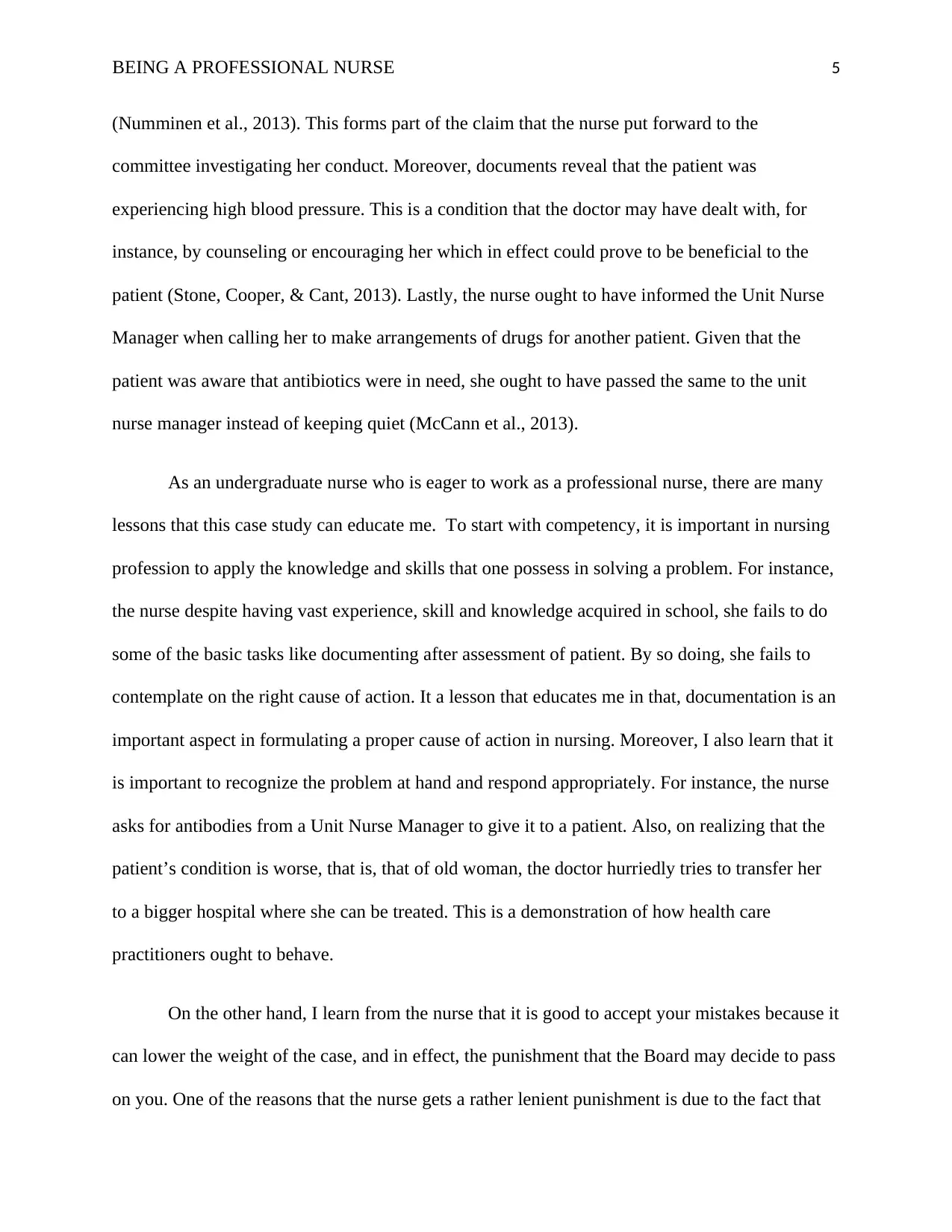
BEING A PROFESSIONAL NURSE 5
(Numminen et al., 2013). This forms part of the claim that the nurse put forward to the
committee investigating her conduct. Moreover, documents reveal that the patient was
experiencing high blood pressure. This is a condition that the doctor may have dealt with, for
instance, by counseling or encouraging her which in effect could prove to be beneficial to the
patient (Stone, Cooper, & Cant, 2013). Lastly, the nurse ought to have informed the Unit Nurse
Manager when calling her to make arrangements of drugs for another patient. Given that the
patient was aware that antibiotics were in need, she ought to have passed the same to the unit
nurse manager instead of keeping quiet (McCann et al., 2013).
As an undergraduate nurse who is eager to work as a professional nurse, there are many
lessons that this case study can educate me. To start with competency, it is important in nursing
profession to apply the knowledge and skills that one possess in solving a problem. For instance,
the nurse despite having vast experience, skill and knowledge acquired in school, she fails to do
some of the basic tasks like documenting after assessment of patient. By so doing, she fails to
contemplate on the right cause of action. It a lesson that educates me in that, documentation is an
important aspect in formulating a proper cause of action in nursing. Moreover, I also learn that it
is important to recognize the problem at hand and respond appropriately. For instance, the nurse
asks for antibodies from a Unit Nurse Manager to give it to a patient. Also, on realizing that the
patient’s condition is worse, that is, that of old woman, the doctor hurriedly tries to transfer her
to a bigger hospital where she can be treated. This is a demonstration of how health care
practitioners ought to behave.
On the other hand, I learn from the nurse that it is good to accept your mistakes because it
can lower the weight of the case, and in effect, the punishment that the Board may decide to pass
on you. One of the reasons that the nurse gets a rather lenient punishment is due to the fact that
(Numminen et al., 2013). This forms part of the claim that the nurse put forward to the
committee investigating her conduct. Moreover, documents reveal that the patient was
experiencing high blood pressure. This is a condition that the doctor may have dealt with, for
instance, by counseling or encouraging her which in effect could prove to be beneficial to the
patient (Stone, Cooper, & Cant, 2013). Lastly, the nurse ought to have informed the Unit Nurse
Manager when calling her to make arrangements of drugs for another patient. Given that the
patient was aware that antibiotics were in need, she ought to have passed the same to the unit
nurse manager instead of keeping quiet (McCann et al., 2013).
As an undergraduate nurse who is eager to work as a professional nurse, there are many
lessons that this case study can educate me. To start with competency, it is important in nursing
profession to apply the knowledge and skills that one possess in solving a problem. For instance,
the nurse despite having vast experience, skill and knowledge acquired in school, she fails to do
some of the basic tasks like documenting after assessment of patient. By so doing, she fails to
contemplate on the right cause of action. It a lesson that educates me in that, documentation is an
important aspect in formulating a proper cause of action in nursing. Moreover, I also learn that it
is important to recognize the problem at hand and respond appropriately. For instance, the nurse
asks for antibodies from a Unit Nurse Manager to give it to a patient. Also, on realizing that the
patient’s condition is worse, that is, that of old woman, the doctor hurriedly tries to transfer her
to a bigger hospital where she can be treated. This is a demonstration of how health care
practitioners ought to behave.
On the other hand, I learn from the nurse that it is good to accept your mistakes because it
can lower the weight of the case, and in effect, the punishment that the Board may decide to pass
on you. One of the reasons that the nurse gets a rather lenient punishment is due to the fact that
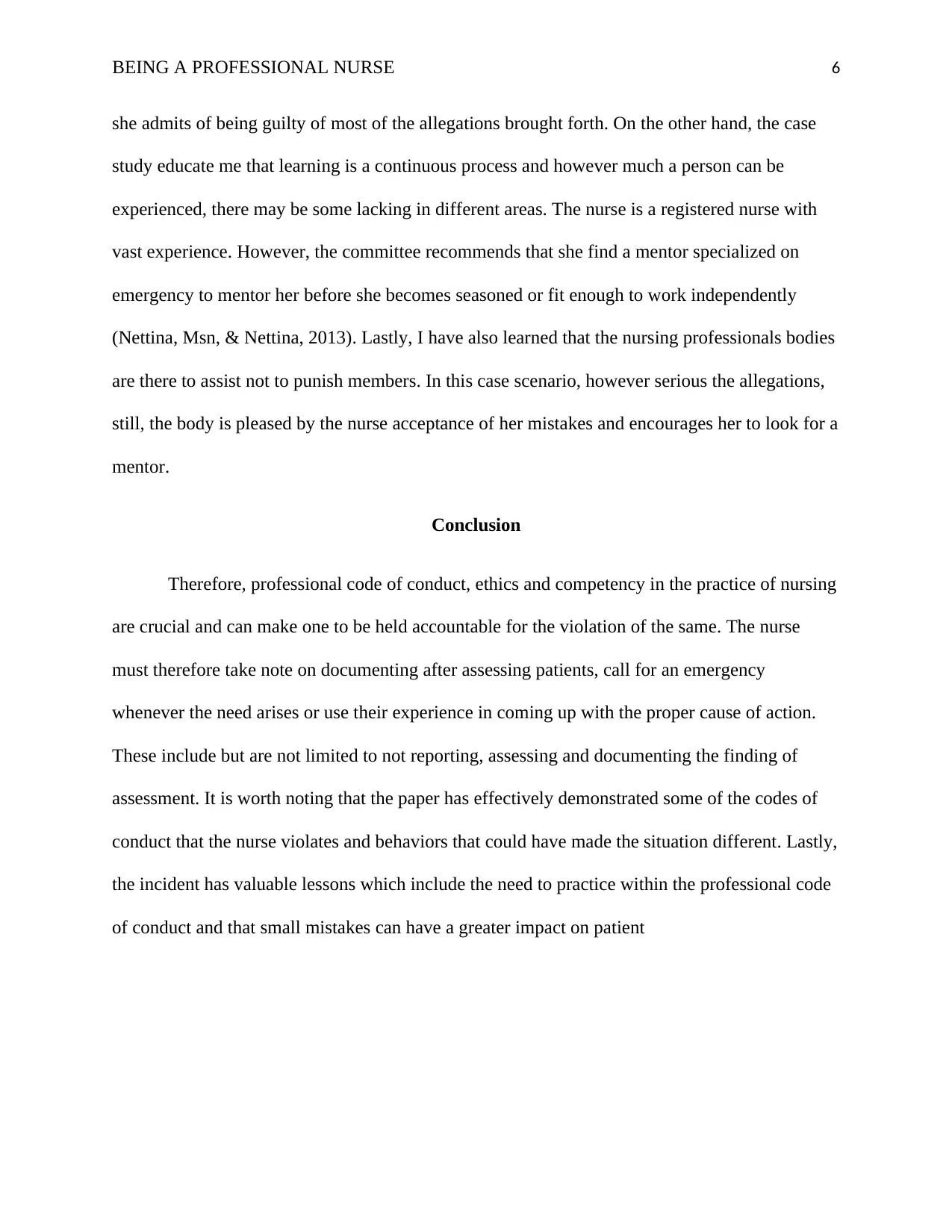
BEING A PROFESSIONAL NURSE 6
she admits of being guilty of most of the allegations brought forth. On the other hand, the case
study educate me that learning is a continuous process and however much a person can be
experienced, there may be some lacking in different areas. The nurse is a registered nurse with
vast experience. However, the committee recommends that she find a mentor specialized on
emergency to mentor her before she becomes seasoned or fit enough to work independently
(Nettina, Msn, & Nettina, 2013). Lastly, I have also learned that the nursing professionals bodies
are there to assist not to punish members. In this case scenario, however serious the allegations,
still, the body is pleased by the nurse acceptance of her mistakes and encourages her to look for a
mentor.
Conclusion
Therefore, professional code of conduct, ethics and competency in the practice of nursing
are crucial and can make one to be held accountable for the violation of the same. The nurse
must therefore take note on documenting after assessing patients, call for an emergency
whenever the need arises or use their experience in coming up with the proper cause of action.
These include but are not limited to not reporting, assessing and documenting the finding of
assessment. It is worth noting that the paper has effectively demonstrated some of the codes of
conduct that the nurse violates and behaviors that could have made the situation different. Lastly,
the incident has valuable lessons which include the need to practice within the professional code
of conduct and that small mistakes can have a greater impact on patient
she admits of being guilty of most of the allegations brought forth. On the other hand, the case
study educate me that learning is a continuous process and however much a person can be
experienced, there may be some lacking in different areas. The nurse is a registered nurse with
vast experience. However, the committee recommends that she find a mentor specialized on
emergency to mentor her before she becomes seasoned or fit enough to work independently
(Nettina, Msn, & Nettina, 2013). Lastly, I have also learned that the nursing professionals bodies
are there to assist not to punish members. In this case scenario, however serious the allegations,
still, the body is pleased by the nurse acceptance of her mistakes and encourages her to look for a
mentor.
Conclusion
Therefore, professional code of conduct, ethics and competency in the practice of nursing
are crucial and can make one to be held accountable for the violation of the same. The nurse
must therefore take note on documenting after assessing patients, call for an emergency
whenever the need arises or use their experience in coming up with the proper cause of action.
These include but are not limited to not reporting, assessing and documenting the finding of
assessment. It is worth noting that the paper has effectively demonstrated some of the codes of
conduct that the nurse violates and behaviors that could have made the situation different. Lastly,
the incident has valuable lessons which include the need to practice within the professional code
of conduct and that small mistakes can have a greater impact on patient
⊘ This is a preview!⊘
Do you want full access?
Subscribe today to unlock all pages.

Trusted by 1+ million students worldwide
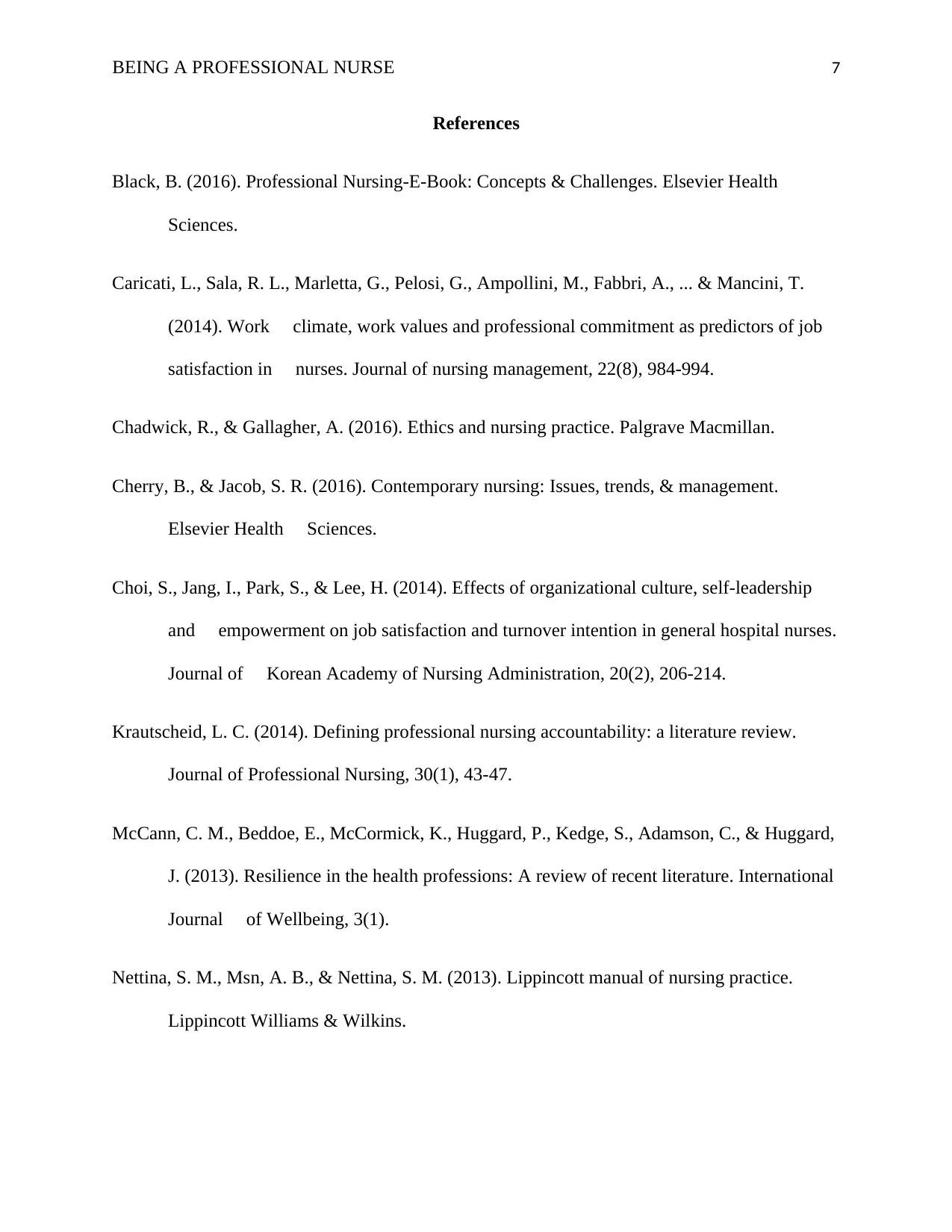
BEING A PROFESSIONAL NURSE 7
References
Black, B. (2016). Professional Nursing-E-Book: Concepts & Challenges. Elsevier Health
Sciences.
Caricati, L., Sala, R. L., Marletta, G., Pelosi, G., Ampollini, M., Fabbri, A., ... & Mancini, T.
(2014). Work climate, work values and professional commitment as predictors of job
satisfaction in nurses. Journal of nursing management, 22(8), 984-994.
Chadwick, R., & Gallagher, A. (2016). Ethics and nursing practice. Palgrave Macmillan.
Cherry, B., & Jacob, S. R. (2016). Contemporary nursing: Issues, trends, & management.
Elsevier Health Sciences.
Choi, S., Jang, I., Park, S., & Lee, H. (2014). Effects of organizational culture, self-leadership
and empowerment on job satisfaction and turnover intention in general hospital nurses.
Journal of Korean Academy of Nursing Administration, 20(2), 206-214.
Krautscheid, L. C. (2014). Defining professional nursing accountability: a literature review.
Journal of Professional Nursing, 30(1), 43-47.
McCann, C. M., Beddoe, E., McCormick, K., Huggard, P., Kedge, S., Adamson, C., & Huggard,
J. (2013). Resilience in the health professions: A review of recent literature. International
Journal of Wellbeing, 3(1).
Nettina, S. M., Msn, A. B., & Nettina, S. M. (2013). Lippincott manual of nursing practice.
Lippincott Williams & Wilkins.
References
Black, B. (2016). Professional Nursing-E-Book: Concepts & Challenges. Elsevier Health
Sciences.
Caricati, L., Sala, R. L., Marletta, G., Pelosi, G., Ampollini, M., Fabbri, A., ... & Mancini, T.
(2014). Work climate, work values and professional commitment as predictors of job
satisfaction in nurses. Journal of nursing management, 22(8), 984-994.
Chadwick, R., & Gallagher, A. (2016). Ethics and nursing practice. Palgrave Macmillan.
Cherry, B., & Jacob, S. R. (2016). Contemporary nursing: Issues, trends, & management.
Elsevier Health Sciences.
Choi, S., Jang, I., Park, S., & Lee, H. (2014). Effects of organizational culture, self-leadership
and empowerment on job satisfaction and turnover intention in general hospital nurses.
Journal of Korean Academy of Nursing Administration, 20(2), 206-214.
Krautscheid, L. C. (2014). Defining professional nursing accountability: a literature review.
Journal of Professional Nursing, 30(1), 43-47.
McCann, C. M., Beddoe, E., McCormick, K., Huggard, P., Kedge, S., Adamson, C., & Huggard,
J. (2013). Resilience in the health professions: A review of recent literature. International
Journal of Wellbeing, 3(1).
Nettina, S. M., Msn, A. B., & Nettina, S. M. (2013). Lippincott manual of nursing practice.
Lippincott Williams & Wilkins.
Paraphrase This Document
Need a fresh take? Get an instant paraphrase of this document with our AI Paraphraser
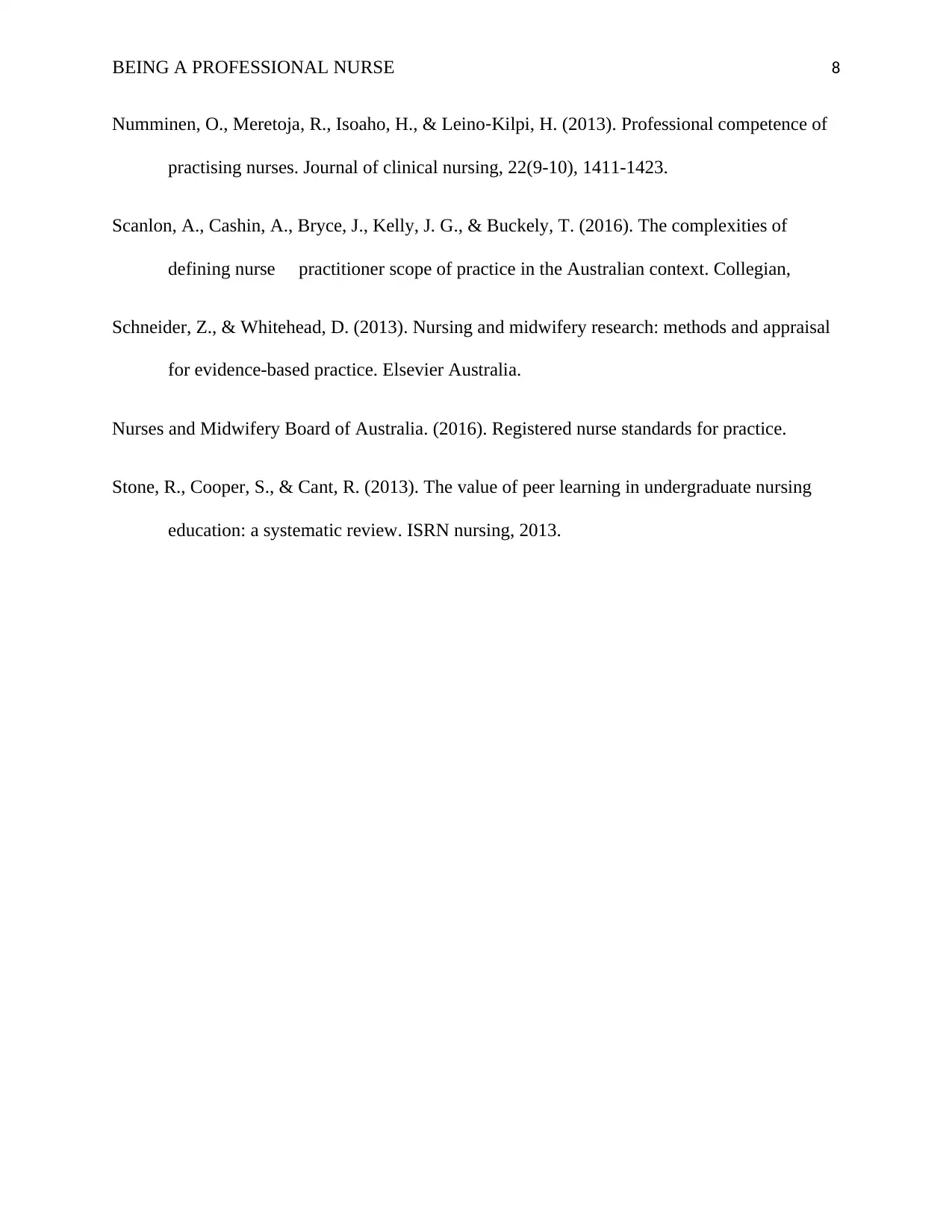
BEING A PROFESSIONAL NURSE 8
Numminen, O., Meretoja, R., Isoaho, H., & Leino‐Kilpi, H. (2013). Professional competence of
practising nurses. Journal of clinical nursing, 22(9-10), 1411-1423.
Scanlon, A., Cashin, A., Bryce, J., Kelly, J. G., & Buckely, T. (2016). The complexities of
defining nurse practitioner scope of practice in the Australian context. Collegian,
Schneider, Z., & Whitehead, D. (2013). Nursing and midwifery research: methods and appraisal
for evidence-based practice. Elsevier Australia.
Nurses and Midwifery Board of Australia. (2016). Registered nurse standards for practice.
Stone, R., Cooper, S., & Cant, R. (2013). The value of peer learning in undergraduate nursing
education: a systematic review. ISRN nursing, 2013.
Numminen, O., Meretoja, R., Isoaho, H., & Leino‐Kilpi, H. (2013). Professional competence of
practising nurses. Journal of clinical nursing, 22(9-10), 1411-1423.
Scanlon, A., Cashin, A., Bryce, J., Kelly, J. G., & Buckely, T. (2016). The complexities of
defining nurse practitioner scope of practice in the Australian context. Collegian,
Schneider, Z., & Whitehead, D. (2013). Nursing and midwifery research: methods and appraisal
for evidence-based practice. Elsevier Australia.
Nurses and Midwifery Board of Australia. (2016). Registered nurse standards for practice.
Stone, R., Cooper, S., & Cant, R. (2013). The value of peer learning in undergraduate nursing
education: a systematic review. ISRN nursing, 2013.
1 out of 8
Related Documents
Your All-in-One AI-Powered Toolkit for Academic Success.
+13062052269
info@desklib.com
Available 24*7 on WhatsApp / Email
![[object Object]](/_next/static/media/star-bottom.7253800d.svg)
Unlock your academic potential
Copyright © 2020–2025 A2Z Services. All Rights Reserved. Developed and managed by ZUCOL.





